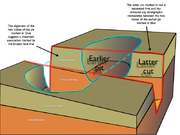
Alignment (archaeology)
Encyclopedia

Archaeology
Archaeology, or archeology , is the study of human society, primarily through the recovery and analysis of the material culture and environmental data that they have left behind, which includes artifacts, architecture, biofacts and cultural landscapes...
is a secondary or circumstantial form of evidence used to associate
Archaeological association
Association in archaeology has more than one meaning and is confusing to the layman. Archaeology has been critiqued as a soft science with a somewhat poor standardization of terms.-Finds and objects:...
features
Feature (archaeology)
Feature in archaeology and especially excavation has several different but allied meanings. A feature is a collection of one or more contexts representing some human non-portable activity that generally has a vertical characteristic to it in relation to site stratigraphy. Examples of features are...
such as postholes by virtue of their physical relationships rather than stratigraphic ones. Features dissected by latter intrusions can have their constituent parts re-associated
Archaeological association
Association in archaeology has more than one meaning and is confusing to the layman. Archaeology has been critiqued as a soft science with a somewhat poor standardization of terms.-Finds and objects:...
by looking at alignments.
Larger scale alignments
The alignment of features on a site with-in or across several archaeological phaseArchaeological phase
Archaeological phase and phasing refers to the logical reduction of contexts recorded during excavation to near contemporary archaeological horizons that represent a distinct "phase" of previous land use. These often but not always will be a representation of a former land surface or occupation...
s many times is an indication of a larger topology to the formation of features relating to activity in the archaeological record. Structures buildings and liner features such as ditches can all have common alignments that relate to a feature that is not exposed during excavation or is off-site. An example would be that a road has biased the alignment of features some way back from the actual road side. Another example will be contours or water courses which may be buried or obscure.
Misinterpretation of alignments
Alignments may or may not be supported by stratigraphic evidence that binds them together in phase. The archaeologist must be wary of making tenuous conclusions based on alignments which have little corroborative evidence.Vertical multi phased alignments
The use of GIS databases has introduced the use of land use groups in post excavationPost excavation
In archaeology once the archaeological record of given site has been excavated, or collected from surface surveys, it is necessary to gain as much data as possible and organize it into a coherent body of information. This process is known as post-excavation analysis, and is normally the most...
study. Here alignments are areas of land use throughout time even if there are across substantive changes in phase
Archaeological phase
Archaeological phase and phasing refers to the logical reduction of contexts recorded during excavation to near contemporary archaeological horizons that represent a distinct "phase" of previous land use. These often but not always will be a representation of a former land surface or occupation...
through the sequence
Sequence (archaeological)
The archaeological sequence or sequence for short, on a specific archaeological site can be defined on two levels of rigour.# Normally it is adequate to equate it to archaeological record. However, the two terms are not exactly interchangeable...
. The use of these non-stratigraphically aligned groups of features by type is that the evolution of land use can be mapped and recalled with the use of a computerized databases storing the information. The typology of land use in these groups is usually broad in definition, examples include; open area,, road, and structure. the idea is create much larger units of understanding for cross comparison between many sites. Land use is also cross referenced to phases that are site specific.
See also
- Fill (archaeology)Fill (archaeology)In archaeology fills are contexts representing material that has accumulated or has been deposited into a cut feature such as ditch or pit of some kind...
- Cut (archaeology)Cut (archaeology)In Archaeology and archeological stratification a cut or truncation is a context that represents a moment in time when other archaeological deposits were removed for the creation of some feature such as a ditch or pit...
- Archaeological planArchaeological planAn archaeological plan in an archaeological excavation, is a drawn record of features in the horizontal plane.- Overview :Archaeological plan can either take the form of...
- Post excavationPost excavationIn archaeology once the archaeological record of given site has been excavated, or collected from surface surveys, it is necessary to gain as much data as possible and organize it into a coherent body of information. This process is known as post-excavation analysis, and is normally the most...
- Feature (archaeology)Feature (archaeology)Feature in archaeology and especially excavation has several different but allied meanings. A feature is a collection of one or more contexts representing some human non-portable activity that generally has a vertical characteristic to it in relation to site stratigraphy. Examples of features are...
- PostholePostholeIn archaeology a posthole is a cut feature used to hold a surface timber or stone. They are usually much deeper than they are wide although truncation may not make this apparent....
- Archaeological phaseArchaeological phaseArchaeological phase and phasing refers to the logical reduction of contexts recorded during excavation to near contemporary archaeological horizons that represent a distinct "phase" of previous land use. These often but not always will be a representation of a former land surface or occupation...
- Excavation (archaeology)

